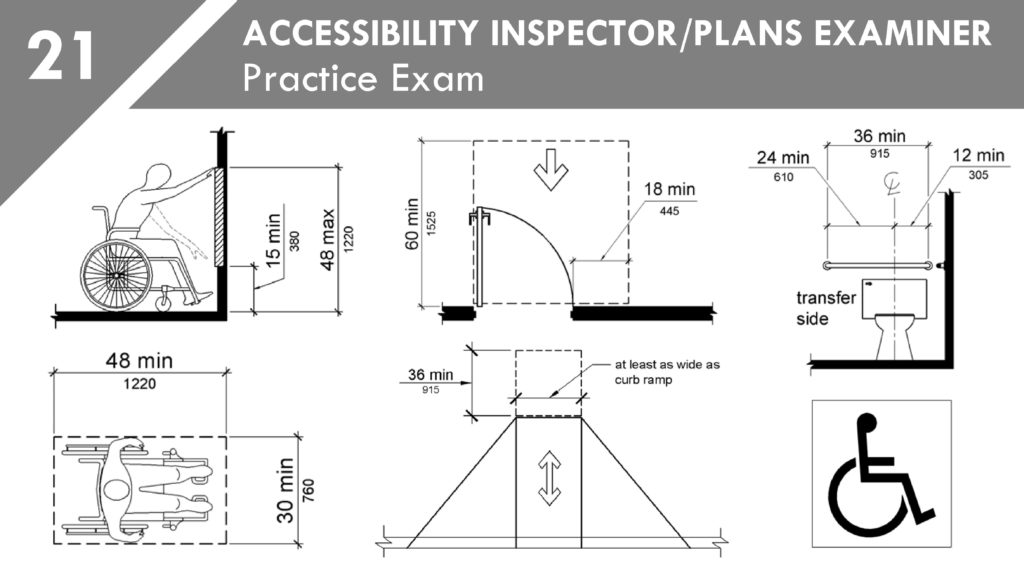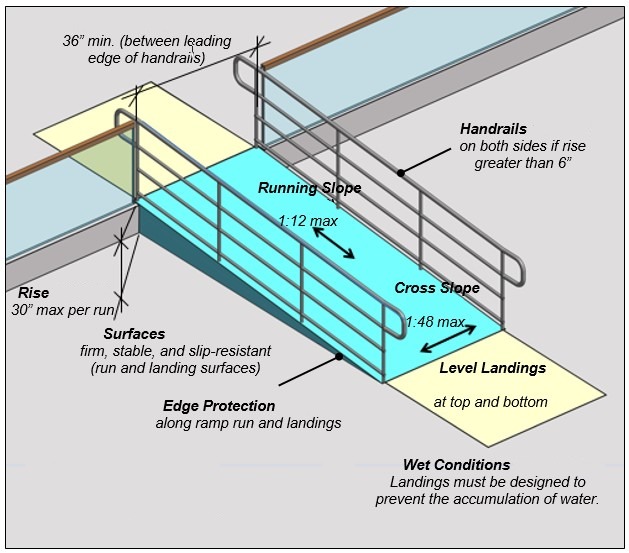
When it comes to construction related accessibility standards associated with buildings, facilities, and their sites, the International Building Code (IBC) contains provisions that set forth accessibility requirements.
Chapter 11 of the IBC contains scoping provisions for accessibility such as determining what is required, where it’s required, and how many are required to be accessible. As for the technical provisions such as how to achieve compliance, the IBC uses ANSI A117.1 as the reference standard to be designed and constructed in accordance with.
The IBC requires sites, buildings, structures, facilities, elements, and spaces (whether temporary or permanent), to be accessible to individuals with physical disabilities by being designed and constructed in accordance with the International Building Code (IBC) and ANSI 117.1 – Accessible and Usable Buildings and Facilities.
With that said, a Ramp is a common feature that provided access from one area to another. When an accessible route is required, a ramp can be provided given it complies with the technical requirements of Section 405 of ANSI A117.1.
We will look into the following features of what makes a ramp accessible, such as:
- Ramp Slope
- Ramp Width
- Ramp Rise
- Ramp Landings
- Ramp Handrails
- Ramp Edge Protection
Let’s begin…
Ramp Slope
A ramp can be defined by having two slopes that determine if it is an accessible ramp. The running slope and the cross slope. The running slope is the slope of the ramp that is parallel to the direction of travel, and the cross slope is the slope that is perpendicular to the direction of travel.

Ramp Running Slope
The maximum running slope of a ramp run cannot exceed a ratio of 1:12. Basically 8.33%. Any ramp having a slope steeper than this is not considered an accessible ramp and cannot be used as part of an accessible route.
There is a minimum slope of a ramp as well. Basically in order to be considered a ramp it must have a slope greater than 5% (1:20). The reason for this is if the slope of the walking surface is less than 5%, it is not considered a ramp therefore all of the features associated with a ramp, such as handrails, edge protection, width, rise, etc…, is not required.
At this point a walking surface less than a 5% slope is considered just that, a walking surface and walking surfaces must comply with Section 403 of ANSI A117.1.
Ramp Cross Slope
Now for the cross slope. The cross slope is the slope that is perpendicular to the direction of travel. This maximum cross slope of a ramp run cannot exceed a ratio of 1:48, basically 2%. A ramp having a cross slope steeper than this is not allowed and is not considered to be accessible.
Ramp Width
An accessible ramp must maintain a minimum width in ordered to be considered accessible. The clear width of a ramp run must be a minimum 36 inches. Similar to stairs, ramps also have handrail requirements however for accessible ramps, handrails and their supports shall not project into the minimum width that is required for a ramp.
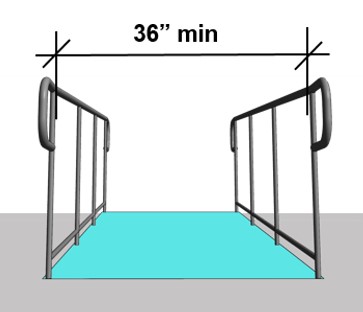
Ramp Rise
A ramp run is considered the sloped part of a ramp and the ramp run does not include the landing required for the ramp. Basically a ramp is made up of a ramp run and its landings. This being said a ramp run can only take you up an elevation of 30 inches maximum before it has to end or a intermediate landing is provided to start another ramp run which also cannot exceed 30 inches in rise.
Ramp Landing
As for the landing of a ramp, the slope, width, and length must be considered. Also a landing is required at both the top and bottom of a ramp run.
Landing Slope
The slope of a landing must not be steeper than a ratio of 1:48, basically 2%.
Landing Width
The width of a landing must be at least as wide as the ramp run that leads to the landing. If a ramp run is 36 inches in width, the landing also must be 36 inches in width. If the ramp run is 48 inches in width, the landing also must be 48 inches in width, and so on.
Length of Landing
As for the required length of a landing, it shall be a minimum 60 inches in length.
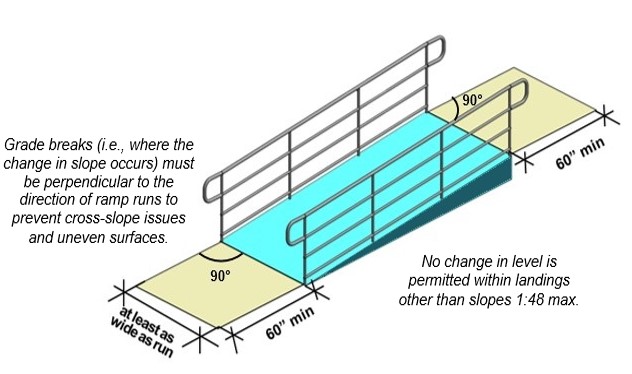
Change in Direction
Sometimes a ramp will be designed so that is turns rather than just having a straight rise alone. If this is the case, the intermediate landing at ramps that change direction must be sized to provided a turning space as required by Section 304.3. This section basically requires a 60 inch diameter clear space to turn safely in a wheelchair. Therefore when a ramp has a change in direction, the intermediate ramp landing must be a minimum 60 inches by 60 inches in size.
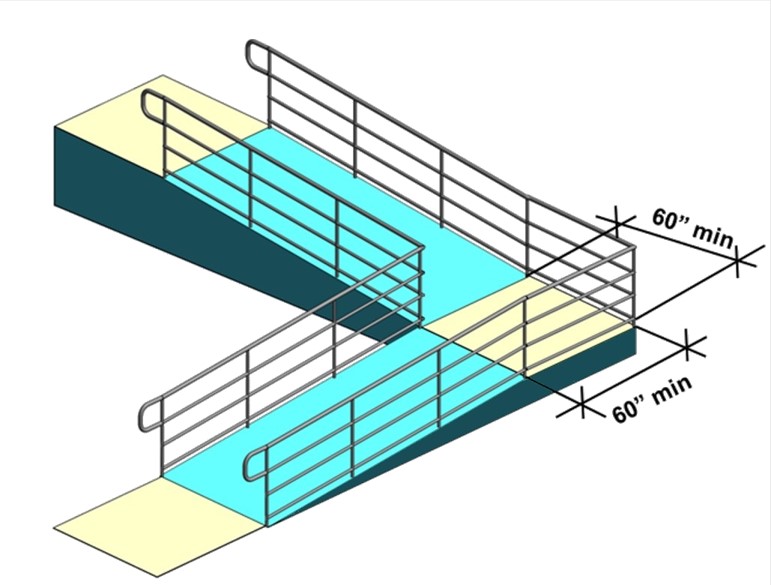
Doorways Adjacent to Landings
When there is a doorway adjacent to a ramp landing, the maneuvering clearance for the door is allowed to overlap the landing. If the door can be locked then the landing must be provided with a turning space that is 60 inches. Basically the landing that is adjacent to a lockable door must be a minimum 60 inches by 60 inches in size.
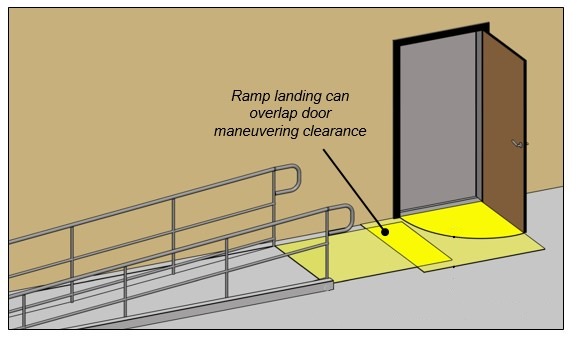
Wet Conditions
Landings that occur in places resulting in wet conditions must be designed such that water cannot accumulate.
Ramp Handrails
Handrails are an important feature of an accessible ramp and they are required for ramps with a rise greater than 6 inches. The handrail requirements are found in Section 505.
According to Section 505, handrails are required on both sides of ramps. They shall be continuous within the full length of each ramp run. The top of the handrail shall be location a minimum 34 inches to a maximum 38 inches above the ramps surface. A clearance of 1-1/2 inches minimum must be provided between the gripping surface of the handrail to any adjacent surface.

Handrails must also extend beyond the ramp run at both the top and bottom. They shall extend over the landing a minimum 12 inches beyond the top and bottom of the ramp run.

As for the size of the handrail itself, there are two types: Circular and Noncircular.
For circular handrails, the cross section shall have an outside diameter of 1-1/4 inches minimum to 2 inches maximum.

For noncircular handrails, the cross section shall have a perimeter dimension of 4 inches minimum to 6-1/4 inches maximum while having a cross section dimension of 2-1/4 inches maximum.
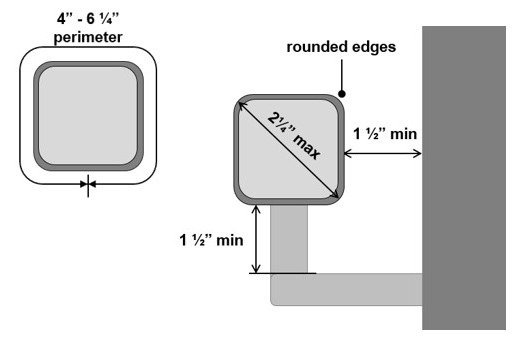
Ramp Edge Protection
Edge protection shall be provided on each side of a ramp run and at each side of a ramp landing. This can be achieved in three ways. Either by an extended floor surface, a curb, or a barrier.
Extended Floor Surface
If the floor surface of a ramp run or ramp landing extends a minimum 12 inches beyond the inside face of the ramps handrail, then this shall meet the edge protection requirement.

Ramp Curb or Ramp Barrier
A curb or barrier can be provided as well in lieu of extending the floor surface.
Curb
If a curb is used to provide edge protection, it must be a minimum 4 inches in height.

Barrier
If a barrier is used to provide edge protection, it must be construction such that it prevents the passage of a 4 inch diameter sphere within 4 inches of the floor. This is commonly achieved by adding horizontal railing above the floor as shown.
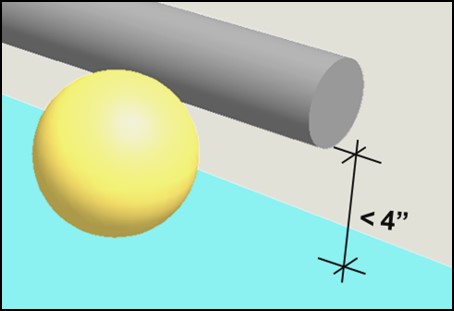
Edge Protection Exceptions
There are however several exceptions to not provide edge protection at specific locations.
- Edge protection is not required for ramps that do not require handrails and that have the side of the ramp flared a maximum slope of 1:10 (10%). This is basically a curb ramp.
- Edge protection is not required on the side of a ramp landing that serves or receives a ramp run or stairway.
- Edge protection is not required on the side of a ramp landing that has a vertical drop of 1/2 inch maximum within 10 inches horizontally from the landing.
- Edge protection is not required on the side of a ramped aisle when the ramp is providing access to an adjacent seat and aisle access way.
This concludes the accessible ramp requirements as outline in the ANSI 117.1-2009 Accessible and Usable Buildings and Facilities as referenced in the 2015 International Building Code (IBC).
Ever though about becoming a Certified Accessibility Inspector / Plans Examiner?
The International Code Council offers a certification exam for this very topic. If you are looking for a practice exam, go ahead and check out our practice exam at the link below.
